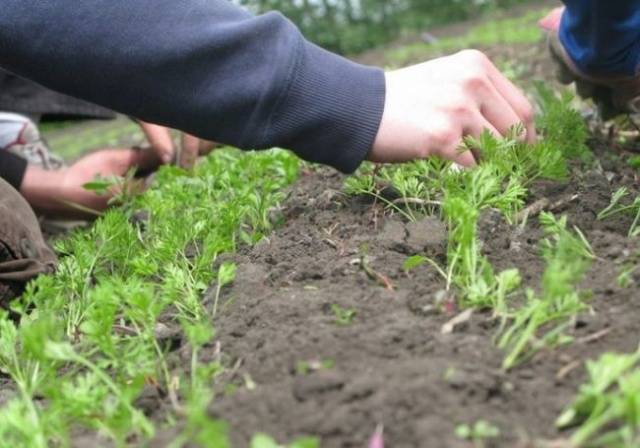Content
Carrots are perhaps the most popular root crop in our Russian household plots. When you look at these openwork, green beds, the mood rises, and the tart smell of carrot tops invigorates. But a good harvest of carrots is not obtained by everyone, but only by those who try to adhere to the basic rules when growing this wonderful root crop and know which "right" varieties need to be planted. One of these varieties is the Canterbury F1 carrot. How it looks can be seen in the photo below:
Description of the variety
Canterbury F1 carrot is a hybrid from Holland, in terms of ripening - medium late (110-130 days from germination). The fruit is of medium length, resembles a cone in shape, with a slightly pointed tip. The weight of one fruit is from 130 to 300 grams, sometimes up to 700 grams. The pulp is dark orange in color with a small core, merging in color with the pulp. Loose, fertile light loamy or sandy loam soil with a lot of humus is suitable for cultivation. The soil should not be clayey and heavy loamy, since the dense crust formed during drying serves as an obstacle to seed germination. Because of this, carrots emerge unevenly.
Nevertheless, in order for the plant to actively grow and develop correctly, watering is necessary. Canterbury F1 carrots are weather resistant and resistant to diseases and pests such as the carrot fly. The variety is high-yielding (about 12 kg per 1 sq. M), a distinctive feature is a long storage time with minimal losses.
Choosing the “right” strain is only half the battle. The most important thing is ahead. And it all starts with choosing the right place to plant Canterbury carrots.
Where to make a bed for carrots
Carrots of any kind love the sun. Lighting a carrot bed is essential for a good harvest. If the Canterbury F1 carrots grow in a shaded area, this will affect the yield and taste for the worse. Therefore, the area where the carrot bed is supposed to be located should receive sunlight throughout the day.
In addition, it is important which crops grew in a given place before.
Carrots must not be grown after:
- parsley;
- dill;
- parsnip;
- celery.
Carrots can be planted after:
- tomatoes;
- cucumbers;
- Luke;
- garlic;
- potatoes;
- cabbage.
When to sow carrots
It is very important to plant Canterbury F1 carrots on time. The sowing time is reflected in the yield. Each variety has its own ripening period. Canterbury F1 carrots reach technical maturity in 100-110 days, and fully ripen only after 130 days. This means that the sowing of seeds should be done at the end of April, as soon as the land allows. And you can sow it before winter, then the ripening period may decrease, and harvest as early as possible.
Preparing seeds for spring sowing
First you need to prepare seeds in order to reject non-viable and sick. You can use the usual soak. To do this, they should be placed in warm water. After 9-10 hours, all unusable seeds will be on the surface of the water. They must be collected and discarded. Dry the remaining seeds, but do not dry them out so that they remain slightly damp. And if there is a desire to taste these fruits early, then you can accelerate the germination process by placing them on a damp cloth or gauze and soak for 3-4 days at a temperature not lower than 20 ° C.Soon, the seeds will begin to hatch and even roots will appear. This seed can be used to plant a small plot of land so that fresh Canterbury F1 carrots can be consumed at the end of May.
Preparing the soil for spring sowing
Canterbury F1 carrots grow best in loose, fertile, light soil. If the soil is not loose enough, then the carrot will grow clumsy, it can be large, but ugly and inconvenient to process. According to experienced gardeners, it is better to prepare a carrot bed in the fall, then in the spring it will only be necessary to loosen it. When digging the earth, humus, wood ash should be added.
Conditions for sowing seeds
- You need to choose a dry, windless day so that the wind does not scatter them all over the garden.
- Before sowing the seeds of Canterbury F1 carrots, not very deep grooves (1.5-2 cm) should be made on the loosened soil at a distance of about 20 cm.
- Spill grooves with plenty of warm water.
- Spread out the seeds, adjusting the distance between them to 1-1.5 cm. Too frequent planting will lead to the fact that the fruits grow small.
- Level the grooves and pat the soil a little with your hand.
The photo below shows how to make grooves:
For the early emergence of seedlings, you can cover the bed with a film or covering material.
Thinning, timing and number of times
To eat tasty, sweet, large and beautiful carrots, it is necessary to regularly cultivate the soil, that is, weed and thin out. It so happens that weeding needs to be done before germination. How to do this in order not to harm the plants?
There is one simple and useful way: while sowing carrot seeds, while the grooves are not yet closed, sow radishes between them. The radish grows much faster, so two different crops can be harvested from the same bed. And when weeding the beds, the radish will serve as a guide.
For the first time, Canterbury F1 carrots should be thinned when true leaves appear. Leave about three centimeters between the plants. The second thinning occurs somewhere in early-mid June, when the diameter of the fruit becomes at least 1 cm.This time, there should be about 5-6 cm between the plants.
The Canterbury F1 carrot variety is easy to maintain and can be stored well until the next harvest.
Testimonials















